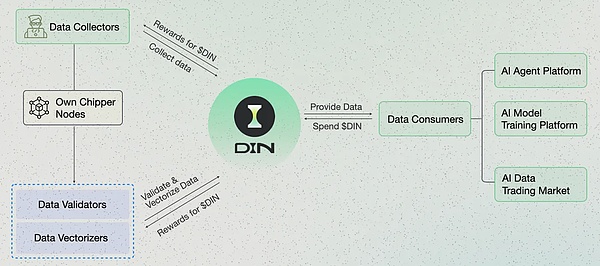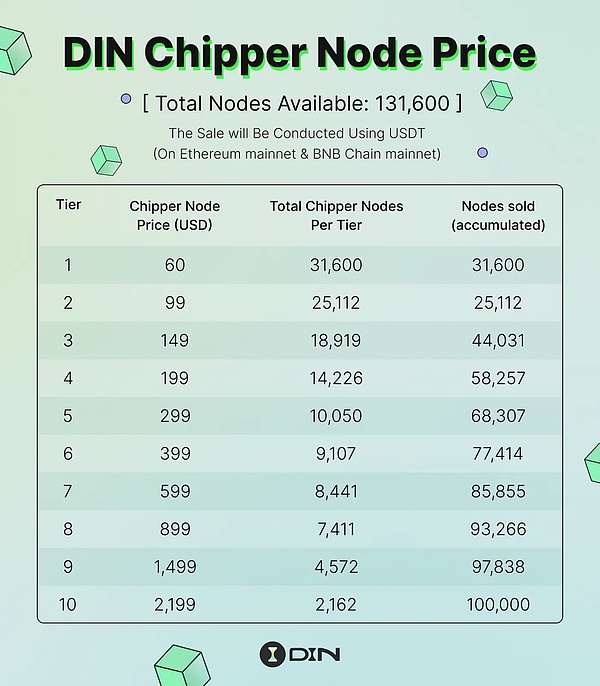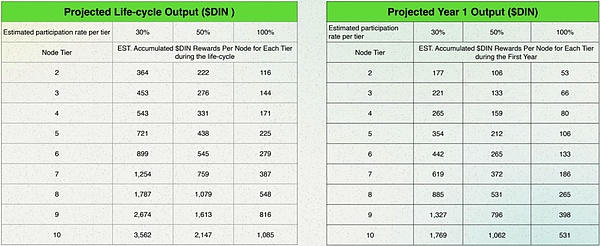Preface
AI is undoubtedly one of the hottest tracks in the world today. Whether it is OpenAI in Silicon Valley or Moonshot and Zhipu Qingyan in China, a number of cutting-edge entrepreneurs and traditional large companies have successively entered this AI revolution. It not only leads the trend in the field of science and technology, but is also one of the most outstanding areas in the cryptocurrency market this year. Looking at the projects listed on major CEXs this year, despite the recent market turmoil, AI leader Bittensor (TAO) still leads all new coins this year with a return rate of more than 5 times. With the continuous development and application of AI technology, data, as the cornerstone of AI development, has become increasingly important.
In the flood of the AI era, the importance and potential value of data have been pushed to an unprecedented height
According to statistics, the current mainstream AI big model companies need to process and consume hundreds of millions of data sets every year. The effectiveness and accuracy of these data directly affect the training effect of AI models. However, the cost of obtaining data is also rising, which has become a major challenge faced by major AI companies.
Performance optimization is supported by the increasing data consumption
In the current market, the amount of data processed and consumed by big model companies every year is very large. For example, OpenAI used about 45TB of text data to train the GPT-3 model, and the cost of training GPT-4 was as high as 78 million US dollars; the computing cost of Google training its Gemini Ultra model was about 191 million US dollars. This huge data demand is not limited to OpenAI. Other AI companies such as Google and Meta also need to process massive amounts of data when training large AI models.
The validity of data needs to be paid attention to
Effective data needs to be high-quality, unbiased, and rich in feature information to ensure that the AI model can learn from it and make accurate predictions. For example, when training GPT-3, OpenAI used text data from various sources, including books, articles, and websites, to ensure the diversity and representativeness of the data. However, the validity of data depends not only on its source, but also on multiple links such as data cleaning, labeling, and preprocessing, which require a lot of manpower and resource investment.
The economic factor that cannot be ignored, the cost of data collection and processing
In actual AI model training, the costs of data collection, labeling, and processing are often underestimated, but these costs can be very significant. Specifically, data labeling itself is a time-consuming and expensive process that often requires manual labor. Once the data is collected, it needs to be cleaned, organized, and processed so that AI algorithms can use it effectively. According to a McKinsey report, the cost of training a large AI model can be as high as millions of dollars. In addition, the construction and maintenance of AI companies' data centers and computing infrastructure is also a huge expense.
In general, the training of large AI models requires a large amount of high-quality data, and the quantity, validity, and acquisition cost of these data directly determine the performance and success of AI models. In the future, with the continuous advancement of AI technology, how to efficiently acquire and utilize data will become a key factor in the competition of AI companies.
Modular data preprocessing layer, decentralized AI data solution based on blockchain
Against this background, DIN (formerly known as Web3Go) came into being as the first modular AI native data preprocessing layer. DIN aims to enable everyone to provide data for AI and get paid through decentralized data verification and vectorization, leading a data economy trend where everyone can monetize their personal data and enterprises can obtain data more efficiently and economically. At present, DIN has received $4 million in seed round financing from Binance Labs, and subsequently received an additional $4 million in pre-listing financing from other institutions, communities and KOL networks. The current valuation is $80 million, showing the market's high recognition of its huge potential and future development. Its partners include Polkadot, BNB Chain, Moonbeam Network and Manta Network.
DIN's Data Preprocessing Node - Chipper Node
DIN's market positioning is very clear, and it is committed to building a decentralized data intelligence network in the field of AI and data. Chipper Node plays an important role in the DIN ecosystem, responsible for data verification, vectorization processing and reward calculation, and is the core component of DIN's data preprocessing layer. In order to promote the data economy more widely, DIN has opened the public sale of Chipper Node to encourage more users to participate in the development and maintenance of the network and receive rewards, forming a positive cycle that promotes the coordinated development of the DIN ecosystem and the data economy.
As an emerging token issuance method, the node sales model has quickly become popular in the crypto market with its unique advantages. Compared with the traditional public sales model, it provides investors with more flexibility and potential returns. The core of this model is that by selling nodes, project parties can better incentivize early participants while ensuring the decentralization of the network and maximizing economic benefits.
DIN's node sales plan will be carried out in stages, including pre-sale rounds, whitelist sales rounds and public sales rounds, each with different participation conditions and reward mechanisms. The reward distribution and unlocking rules of node tokens are also carefully designed to ensure the stability of market prices and long-term returns for investors. By purchasing and running DIN's Chipper Node, users can not only participate in the process of data verification and vectorization, but also receive generous $DIN token rewards.
With the continuous development of the AI and data markets, DIN is expected to become a leader in this field. The following article will explore DIN's Chipper Node node sales model and its unique advantages in the market, and reveal its future investment potential and development prospects by analyzing the rate of return and payback period.

Expected rate of return and payback period analysis
DIN's node sales plan will be carried out in stages, including pre-sale rounds, whitelist sales rounds and public sales rounds, each with different participation conditions and reward mechanisms. The reward distribution and unlocking rules of node tokens have also been carefully designed to ensure the stability of market prices and long-term returns for investors. By purchasing and running DIN's Chipper Node nodes, users can not only participate in the process of data verification and vectorization, but also receive $DIN token rewards from node mining. The following is a detailed analysis of the expected return rate and payback period of DIN node sales.
DIN Sales Plan
Node Token Reward Distribution Plan: DIN's node tokens account for 25%, and 50% will be unlocked in the first year. In addition to the node mining rewards themselves, additional $DIN tokens will be airdropped to $xDIN holders, unlocking 100% at the TGE; at the same time, 13% of the tokens will be airdropped to Chipper node holders, and will be unlocked linearly 6 months after the TGE. This distribution plan helps to maintain the stability of the token market price and reduce price fluctuations caused by a large number of tokens entering the market in a short period of time.
DIN's node sales are divided into three stages: pre-sale round, whitelist sales round and public sales round. The sales price and conditions of each stage are different to attract different types of investors. The pre-sale round is mainly for early product users and core community contributors; the whitelist sales round is for specific institutions, communities and KOL partners; the public sales round is open to the general public investors.
Invitation mechanism: DIN has introduced an invitation mechanism. When old users invite new users to purchase nodes, both parties can get additional token rewards. This mechanism can not only effectively expand the user base, but also improve the activity and loyalty of the community

Prices and return cycles of nodes in different rounds
The total supply of $DIN is 100 million. Compared with other DePIN projects, we can see that io.net, which has also opened node sales and received a total of US$10 million in financing before TGE, currently has a FDV of 1.5 billion. Taking this as a benchmark, assuming that the unit price of $DIN after TGE is $15 and the number of people running the node is 50%, we can estimate the expected return and payback period of investors in each stage within one year (excluding airdrop rewards).
The nodes of Tier 1 in the pre-sale round are free to eligible xData Chip NFT holders and some community contributors, without having to consider the return on investment; at the same time, they can start mining early, convert their wafers into airdrop points $xDIN in advance, and lock in the share of $DIN token airdrops.
The node price of Tier 2 in the whitelist sales round is US$99, and you can get a node reward of 106 $DIN in the first year, which corresponds to US$1,590. At the same time, according to the release rules, the buyer will get back the investment within 27 days.
The public sale round is divided into two phases, the first phase (Tier 3 - 5) and the second phase (Tier 6 - 10). The node price of Tier 3 is US$149, and the node reward obtained in the first year is 133 $DIN, which corresponds to a value of 1,995, and the buyer will get back the investment within 36 days. The price of Tier 6 is $300, and the node reward in the first year is $265 DIN, which corresponds to a value of $3975, and the purchaser will still get his money back within 3 months.

Compared with other mainstream projects that have recently opened node sales, such as Aethir and CARV, DIN's node sales have more advantages in price, unlocking speed and reward mechanism. Aethir's node tokens are unlocked in four years, and the payback period is longer. Although CARV adopts a multi-round sales strategy, the overall return rate is not as good as DIN. At the same time, DIN's node sales enable investors to get returns in a shorter time through faster unlocking speed and flexible reward mechanism, while maintaining market price stability and reducing investment risks.
DIN's Technical Strength and Market Potential
Technical Strength
As the first modular AI data preprocessing layer, DIN has outstanding technical innovation and unique advantages. DIN's core technology is to provide efficient and reliable data preprocessing services through decentralized data verification and vectorization processing. This technology not only improves the efficiency of data processing, but also ensures the security and privacy of data. In addition, DIN's Chipper Node has significant advantages in data verification and reward calculation, allowing node holders to directly participate in the operation and maintenance of the network, further enhancing the decentralization and robustness of the network.
Market Potential
The huge potential of the AI and data markets is an important driving force for the development of DIN. With the rapid development of artificial intelligence and big data technology, the market demand for high-quality data is growing. Through its innovative technology and business model, DIN is able to provide efficient data pre-processing services for AI models, thereby significantly reducing the cost of data acquisition and processing. This gives DIN a favorable position in the highly competitive market, with huge market potential and development prospects.
Capital Background
DIN's strong capital background and supporters further enhance its market competitiveness. DIN has completed a $4 million seed round of financing and a $4 million pre-IPO financing, with a current valuation of $80 million. It is worth noting that DIN has received support from top investment institutions such as Binance Labs, which not only provides sufficient financial guarantees for the project, but also provides strong resources and network support for its future development.
Summary
Although the global capital market was hit not long ago and the crypto market plummeted, the panic in the current secondary market has not completely dissipated. However, participating in node sales may be a higher-odds option during market turmoil, and obtain more reliable node reward returns than the secondary market. Through detailed node token reward distribution and flexible sales methods, DIN provides investors with a higher rate of return and a shorter payback period. As macroeconomic conditions stabilize and interest rate cut expectations are realized, the bull market is expected to return in the second half of the year. As a comprehensive modularization, DePIN and AI narrative, DIN is expected to lead a trend of private data economy under the background of rapid development of AI through its decentralized data preprocessing technology, and its performance in the future market is worth looking forward to.
 JinseFinance
JinseFinance
 JinseFinance
JinseFinance JinseFinance
JinseFinance JinseFinance
JinseFinance JinseFinance
JinseFinance JinseFinance
JinseFinance JinseFinance
JinseFinance JinseFinance
JinseFinance Olive
Olive Cheng Yuan
Cheng Yuan Cointelegraph
Cointelegraph